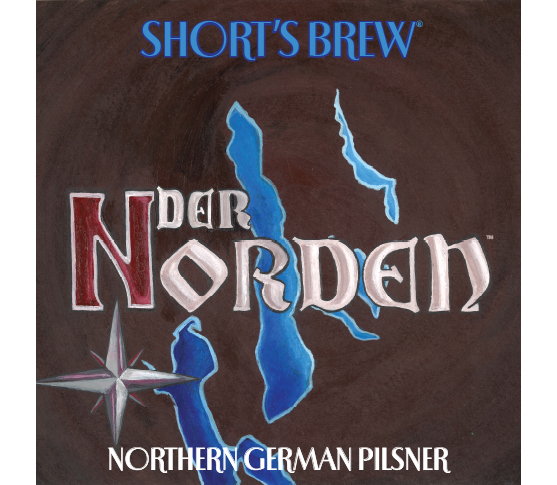
Der Norden
Northern German Pilsner
A golden blond pilsner modeled after a traditional version from northern Germany. Gassy yeast esters join perfectly with delicate aromas of bread and light pilsen malt. The initial mouthfeel is almost creamy, as soft grain and unique mineral flavors transition quickly toward an expected crispness brought on by ample carbonation. A heightened bitterness comes through on cue, with “hay-like” Noble hop characteristics that linger on the palate with a perfect dryness to encourage more refreshing tastes.
- Pub Brews
-
North German Pilsner
- ABV: 5.0%
- IBU: 50
Origin Story
When translated, Der Norden means "the north", which is exactly what this beer is meant to symbolize in many ways. Described as a Northern German Pilsner, this characteristically different version of Germany's most popular beer style (and the worlds), is perfect for Short's considering our own latitudinal positioning here in Michigan's lower peninsula. Similar in many ways to a traditional Chezch Pilsner, where this style originated from, the flavor differences from regional brewing practices in German are enough to signigy this geographical distinction when serving these beers in the country with the world's oldest continuous brewing culture. Pilsner, or Pils for short, is the very first blond lager and arguably the most successful beer style in the world. Nine out of ten beers drunk in the world today are made according to the Pilsner style or a style directly derived from it. Since its creation in the town of Pilsen in the Czech Republic, in 1842, many countries have adopted this instantly popular style, creating their own versions of it. Considering that the Czech Republic did not receive it's independence from the German speaking Austro-Hungarian Empire until after World War I, Pilsner's strong German sounding name and rich history in Germany, make it seem like one of the country's very own historical beer styles. Although Pilsner finds it's German brewing roots in the northern part of the country, the style didn't really take off until Bavarian brewers from the southern region of the country began to brew their own versions of this new Bohemian beer. To learn the difference between the two versions of German pilsner, look no further than the water used to brew the beer. The water in northern Germany is fairly hard which accentuates the up-front bitterness in their pilsners. The water in Bavaria and many other parts of southern Germany tends to be very soft which suppresses the bold hop bitterness. Many of the southern German pilsners favor more mellow hop aromatics, than strong hop flavor and bitterness, which is found in the northern German pilsners. The pilsners are quite different as a result of the different water profiles. Northern German pils are similar in flavor and bitterness to the Czech Pilsen beers, but with distinct differences from the German noble hops used, and more lingering bitterness from the hard (more calcium) content of their water. The beers from southern Germany on the other hand can be more like a Munich Helles (Thirst Mutilator) than a pilsner, with more noticeable malty sweetness and less hop bitterness. At this time there is no distinction between the two types of German pils in the Brewers Association's official stylistic guidelines, but it's important to note these differences when tasting German pilsners that make it a point to distinguish their brewing origin. Wait, don't we have very soft water in Bellaire? How did we accomplish these flavor differences in order to make a beer that resembles the distinct flavor differences of a Northern German Pilsner? The answer is easy and not that uncommon of a practice by craft brewers in America who want to create their own versions of certain true-to-style historical European beers that may have very unique ground water aquifers that helped define the beers of their region. We simply try to recreate the mineral content of their water by adding chemical compounds to our own water to change the composition of it. In this particular instance, we added an increased amount of calcium to the water we mashed in with to make Der Norden, so we could resemble an environment similar to ones that brewers of pilsner in northern Germany would have at their disposal. The end result IS a uniquely different form of Pilsner, that allows the consumer a fun chance to experiment and see if they can pick up on the notable flavor differences, in what is considered a very "light" flavored beer to begin with.Hops
Perle, Hersbrucker
Find Der Norden near me

